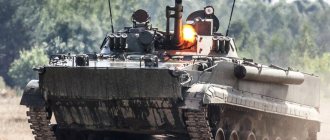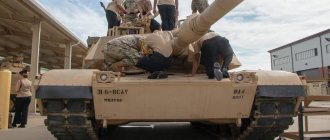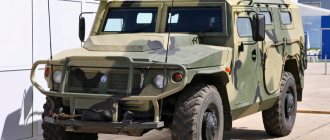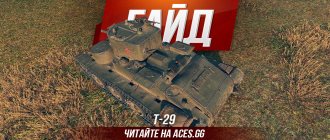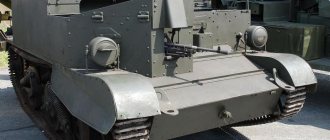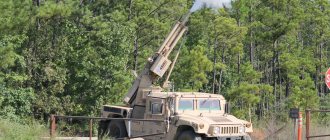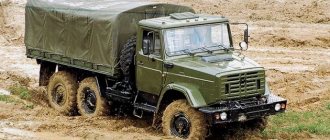Humvee car HMMWV father of Hummer Hummer photo
The Humvee car HMMWV is the father of the Hummer Hummer photo , it was Operation Desert Storm that brought the Humvee wide fame. Footage of the war in the Persian Gulf circulated on all television channels in the world. They invariably featured army all-terrain vehicles, which jokingly overcame the steep slopes of the dunes and walked on the sand as if on asphalt, leaving the ultra-modern M1 Abrams tanks far behind. This advertising turned out to be effective. When, after the end of the conflict, the US armed forces decided to sell several thousand HMMWV Humvees from the father of Hummer Hummer photo , considering it unprofitable to take them back overseas, they did not have to look for civilian buyers for long.
utility vehicle HI
Hummer car photo High Utility, Maximum Mobility, Easy Raiding – HUMMER
In 1992, she introduced the HI utility vehicle into the program - a more convenient civilian version of an army vehicle, which received the officially registered Hummer , which stood for “high versatility, maximum mobility, easy operation” (High Utility, Maximum Mobility, Easy Raiding - HUMMER) . On January 11, 2000, the General Motors Corporation bought the rights to produce and sell the HI model, and in the fall of 2002, in parallel, the production of a more comfortable version of the H2 began, created on units of Chevrolet and GMC SUVs. Since 2005, a new model NZ has been produced. But it all started with the HMMWV, commonly known as the Humvee, one of the world's most common light military vehicles, in service in more than 50 countries. Although here, out of ignorance, they are mistaken for a Hummer.
photo Hummer H2
Hummer H2 photo
The Humvee car HMMWV is the father of the Hummer Hummer photo , a direct successor to the legendary Willys jeep, although more universal, at one time it replaced several types of light army vehicles. The history of the Humvee began in the 1970s, when FMC attempted to create an all-terrain military all-terrain vehicle, conceptually reminiscent of four-wheel drive buggies used for cross-country racing. The built XR311 machine did not go into production, but was subsequently purchased by a young one (formed in 1971) and used as the basis for its own developments. In 1978, in accordance with the Pentagon's requirements for a combat support vehicle, AM General produced two prototypes of the XM966 armored vehicle, which, however, turned out to be too heavy and difficult to control. A new chance presented itself the very next year, when the US Department of Defense announced a competition for the creation of a highly mobile multipurpose vehicle HMMWV (High Mobility Multipurpose Wheeled Vehicle) with a load capacity of 1.25 tons. It was supposed to replace the 0.25-ton M151, 1.25-ton jeeps ton M561 articulated all-terrain vehicles and a number of other light army vehicles.
US Armed Forces HMMWV all-terrain vehicle on patrol. Operation Wolfhound Power. Iraq 2004
One of the customer’s main requirements was the ability to confidently move along a tank’s trail, which explains the Humvee’s wide track (1829 mm) and the large width of the body. In June 1980, she presented a prototype of a new car, designated XM998. Unlike the rear-engine XM966, it received a more familiar layout with a front-mounted power plant. Initially, the car had an 8-cylinder V-shaped Chevrolet gasoline engine with a displacement of 5.7 liters. In April 1982, it introduced a new prototype XM998 with a closed four-door body, a short cargo platform and a characteristic tail shape with a horizontal radiator grille, which received a 130-horsepower Detroit Diesel engine and a hydromechanical gearbox. Along with AM General, the Chrysler and Teledyne Continental concerns took part in the competition for a new army vehicle. Even the famous one tried his luck with his “Chita” model. But the AM General product surpassed all competitors, showing truly phenomenal cross-country ability. On March 22, 1983, the military department issued a contract worth $1.2 billion, which provided for the supply of 55 thousand vehicles over five years. They were assigned the index M998 and the official brand HMMWV (pronounced “Humvee”). The implementation of the billion-dollar contract became a real challenge for a small company.
US Armed Forces HMMWV. Bright Star teachings. Egypt, 2005
It was necessary to provide government subsidies to finalize the design and prepare production facilities. The production of HMMWV production cars began in the winter of 1985. Initially, the car was produced in about 20 additions, but a few years later the number of variants reached fifty. Vehicles of the HMMWV family, weapons carriers, can be armed with Tou ATGMs or small arms - for example, a 12.7 mm M2NV machine gun or a 40 mm Mk 19 automatic grenade launcher.
HMMWV chassis for mounting AIM-12 anti-aircraft missiles
Spanish-American exercises Rota naval base, Spain, 2014
The HMMWV Humvee has a durable spar frame, in the front of which there is a 6.2-liter Detroit Diesel engine (130 hp), an automatic three-speed Hydra-Matic transmission and a two-speed New Process transfer case with locked center differential. All wheels with planetary gears, hydraulic disc brakes and wide-profile radial tires (12.50 x 16.5) are suspended on transverse A-arms and springs with hydraulic shock absorbers. The wheelbase was 3302 mm, track - 1829 mm, ground clearance - 406 mm, overall dimensions - 4700 x 2126 x 1753 mm.
US Army HMMWV all-terrain vehicles. “Humanitarian mission” Iraq, 2004
The basic cargo-passenger four-seater M998 with an aluminum four-door body with a soft top weighed 2855 kg and had a gross weight of 3990 kg. It was also offered as a pickup truck with a two-door cab, towing a single-axle M116A2 trailer, and in the version with a winch it received the M1038 index. They corresponded to the M966 and Ml025 chassis without winches with four-door fully enclosed bodies for mounting weapons on the roof and M1026/M1036 with winches, which with enhanced protection bore the indexes M1043/M1045 and M1044/M1046, respectively.
Humvee HMMWV in service of Afghan border guards. Nangarhar Province, 2012
To transport mini-containers, low-frame chassis M1037 and M1042 were used. The ambulance program included the standard version of the M1035 with a canvas top and the M966 and M997 with all-metal mini and maxi bodies for 2-4 wounded on stretchers. Later, the M1069 light tractor for towing 105 mm guns and the M1097 carrier of heavier weapons with a four-ton winch appeared. In addition, the Avenger self-propelled air defense system was produced on the Humvee chassis. All vehicles developed a speed of 105-112 km/h, had a cruising range of 520 km, overcame slopes up to 60% steep and fords 76 cm deep (with additional preparation - more than 1.5 m). The HMMWV family made its combat debut during Operation Just Goat, the American invasion of Panama in 1989. But they were used on a truly massive scale during the Gulf War in 1990-1991.
Iraqi Armed Forces Humvee. Diyala, Iraq, 2010
After about ten years of serial production, the HMMWV family cars have undergone their first major modification. In 1994, it began producing the modernized army A1 series (this designation was added to the model number - for example, M1025A1, M1037A1, etc.) with a new transfer case, reinforced chassis units and an improved interior. At the same time, the model range expanded - in the same 1994, production of the M1109 variant with an armored body developed by . The very next year it was replaced by the A2 series, equipped with a new 6.5-liter V8 diesel engine (160 hp) with direct injection (our own production), an automatic four-speed Hydra-Matic transmission and a centralized tire pressure regulation system.
Convoy of HMMWV vehicles from 3rd Battalion, 325th Airborne Infantry Regiment, 82nd Airborne Division before leaving Camp Stryker Bogdad
The peculiarities of the combat use of the Humvee in local conflicts have led to the rise in the first place in the family of variants of increased security with local armor. Equipped with a 190-horsepower version of the turbocharged engine, capable of carrying a variety of weapons from machine guns to missile systems and reaching speeds of up to 135 km/h. In 1995, an open combat all-terrain vehicle for the rapid reaction forces M1097A2 “Special Force” was introduced with a total weight of 4.7 tons, armed with 7.62 and 12.7 mm machine guns. In the same year, the 2.3-ton M1113 universal chassis for interchangeable containers appeared, and the M1114 closed four-door armored all-terrain vehicle with a gross weight of 5.5 tons was introduced.
A CH-47 Chinook transports an HMMWV. Kandahar Airport, Operation Kalak Hode, Afghanistan, 2012
Their further development in 1998 was the air transportable version of the M1116 with a rotating turret, capable of protecting the crew from the effects of an anti-tank mine exploding under the bottom. In October 2000, together with the British one, the assembly of open combat and reconnaissance vehicles “Shadow”, intended for rapid reaction forces, began on the M1113 chassis. In 2003, civilian HI SUVs began to be used for border protection, and at the end of 2004, prototypes of promising XM1151 and XM1152 vehicles with increased payload capacity (1.9-2.3 tons), equipped with a 190-horsepower diesel engine, were created on the M1025 and M1097 chassis. and local protection. These vehicles, produced since 2006, as well as the M1165 base chassis, already belong to the third generation of the HMMWV family. To date, the number of manufactured cars of the family exceeds 280 thousand units. The vast majority of them serve in the US armed forces, but they are also found in the armies of other countries. The largest Humvee fleets (from 3 to 7 thousand units in each country) are located in Afghanistan, Egypt, Mexico, and Taiwan.
convoy of military HMMWV Humvee jeeps in New Orleans photo Hurricane Isaac
In the post-Soviet space, Humvees are much less common. 60 of these vehicles serve in the Latvian army. Ukraine received approximately the same number of HMMWVs, where they serve in the 95th Airmobile Brigade and are actively used in the armed conflict in the east of the country.
North Dakota National Guard Humvee HMMWV. Fort Ransom, USA
M1097R1 vehicles of the 1st Infantry Battalion of the US Army. Fort Bliss, Texas
The high performance qualities of the Humvee have given rise to an understandable desire among automakers in other countries to copy it. The greatest success in this has been achieved by the Chinese, where three companies are engaged in the production of HMMWV “clones”. In particular, since 2003 it has been producing the DF2050, based on the civilian Hummer HI, as well as its armored version DF2058. Almost simultaneously with Dong Feng, production of the SFQ2040 car began. Just like the DF2050, it is equipped with a licensed Cummins diesel engine, but has an aluminum body rather than steel. Finally, in 2008, the company began production of its “clone” of the Humvee, designated XL2060. Spain also has its own “clone” of the Humvee – there, since 1998, the URO company has been producing VAMTAC vehicles equipped with 190-horsepower Steyr diesel engines.
All-wheel drive army all-terrain vehicle with local armor Humvee HMMWV photo
The Humvee car HMMWV father of the Hummer Hummer photo , to ford water obstacles the vehicle is equipped with a high exhaust manifold, a rotating turret with an M2NV machine gun is equipped with armored shields with bulletproof glass, four-barreled grenade launchers are mounted in the corners of the body to set up smoke screens, the side doors are equipped with armored linings with bulletproof glass.
To the frequently asked question online, “tiger car vs. hummer,” it’s probably still vs. the HMMWV humvee , the answer is banal, simple. By and large, the American is an all-terrain vehicle with the ability to transport soldiers and equipment, including trailers. Our Tiger photo is an order of magnitude better, due to the fact that it was designed later (and almost everything like a Humvee can), the main thing is that the Tiger is an order of magnitude better in terms of armor class (this is what the Americans are also working on). As always, the question is the scale of production.
Humvee
XR311 is the predecessor of the HMMWV, manufactured by the FMC Corporation.
The idea of developing an all-wheel drive four-wheeled all-terrain combat vehicle for transporting personnel and placing various weapons for the US Armed Forces dates back to the second half of the 1960s, when the FMC Corporation in San Jose (California) took the initiative An experimental multi-purpose vehicle XR311[en] was developed and tested in several implementation options (with an open and closed body), equipped with machine guns, small arms grenade launchers and rocket weapons of various calibers and configurations, depending on the specific option. The XR311 was a two-seater (its crew consisted of a driver and a gunner/operator of on-board weapons) and corresponded to the definition of a combat reconnaissance and patrol vehicle, intended for carrying out various types of reconnaissance activities, search and raid-ambush operations, patrolling, escorting motorized mechanized columns, placing on board anti-aircraft missiles and anti-tank weapons (self-propelled air defense systems or anti-tank systems), control and communications equipment (command-staff version for platoon and company commanders, battalion headquarters officers) and so on. At the same time, it passed factory tests in the mountainous desert areas of California. The vehicle had the following characteristics:[2]
- Wheel formula - 4 × 4
- Engine type - carburetor (gasoline)
- Engine power - 215 hp. With.
- Cruising range - 480 km
- Speed – up to 129 km/h
- Climbability - 60°
- Overcoming wall - 0.5 m
- Fordability - 0.76 m
- Transmission - automatic, three-speed
In terms of its overall characteristics, it approximately corresponded to the serial half-ton SUV M155 (MUTT type).[2]
This vehicle was developed for the Army and purchased in ten pre-production copies (in addition to the two initial prototypes) for trial operation in regular military units, which the vehicles successfully completed by 1972, followed by testing by reconnaissance units of the 2nd Armored Division, but since The army generals considered it inappropriate at that time to purchase automotive equipment of this kind in favor of more heavily armed and better armored tracked vehicles, the project was postponed[3].
The Armored Directorate formulated a list of requirements for the vehicle being developed; it had to have:[4]
- diesel engine
- automatic transmission
- protective coating of the body and glass (ballistic protection) from fragments and bullets at takeoff
- gross vehicle weight with cargo up to 3400 kg.
In addition, the machines of the development companies participating in the competition were required to:
- accelerate from zero to 48 km/h in six to eight seconds
- transport a load weighing 1135 kg
- overcome a 45 cm vertical obstacle
- provide air transportability on board or on an external sling of the UH-60A Blackhawk helicopter
- independently leave the place of shelling on shot-out flat tires.
| AM General | Chrysler Defense | Teledyne-Continental |
After the Pentagon announced a competition for a “highly mobile multi-purpose wheeled vehicle” in 1979, [5] FMC did not participate in it, selling its developments and the rights to them to the AM General corporation, which specialized in the production of various official vehicles, which was admitted to participate in the competition in July of the same year. Also participating in the competition were their own Chrysler Defense prototypes (soon to be part of General Dynamics) with an original design and increased clearance between the underbody and the supporting surface; Teledyne Continental[en] with a squat-looking car (which is a modified Italian Lamborghini Cheetah buggy, comically called “Rambo-Lambo”), with a low silhouette and various options for covering the upper part of the body - open, canvas or metal; American LaFrance[en] with some semblance of a cash-in-transit vehicle with an open or canvas top and rectangular contours; Four Wheel Drive[en] with a design that looks like a golf car.
Having received the design documentation for the XR311, AM General engineers made a number of adjustments: they increased the dimensions of the vehicle by lengthening the wheelbase, with the prospect of converting the cargo compartment into a troop compartment for transporting military personnel; slightly modified the design and positioned the windshield at a right angle (a characteristic external difference between their model and many other all-terrain vehicles of that time and today).[3] A working prototype of the XM966 all-terrain vehicle passed its first tests in July 1980 in the Nevada desert at the Nevada Automotive Test Center. By early 1981, each example had covered approximately 17,000 miles. Initially, AMG did not change the layout of the car they inherited from FMC, but before the final tests, the corporation's engineers made a radical change to place the car's engine in the front of the car while maintaining the exterior, so in the final round AMG was represented by front-engine prototypes. In April 1982, the applicants produced pilot batches of their machines for final testing. The vehicles were placed at the complete disposal of the US Army for five months. The cars of Chrysler, AM General and Teledyne-Continental[6] reached the finals of the competition.
After development tests, on March 22, 1983, a contract was signed with AM General for the production of 54,973 vehicles[7]. The wholesale price was about $22,000. Serial production began in January 1985 at the AM General plant in Indiana.
Motor Trends: How does the Humvee compare to the new Oshkosh JLTV
Not long ago, US industry began mass production of new multi-purpose military vehicles Oshkosh JLTV. This equipment is intended to replace existing HMMWV vehicles and was created taking into account the experience of their operation. It is expected that new cars will become a full-fledged replacement of existing ones, but due to a number of characteristic differences they will be able to more effectively solve the same problems. Naturally, plans to replace one car with another could not help but raise the question: which is better, HMMWV or JLTV.
In May last year, the American publication Motor Trends offered its own version of a comparison of two army vehicles. Although the article “How the Humvee Compares to the New Oshkosh JLTV” by Christian Seabo cannot be called new, it still has not lost its relevance and is of some interest.
The author begins his article with a reminder of current events. After three decades of faithful service, the HMMWV (High Mobility Multipurpose Wheeled Vehicle) multipurpose vehicle from AM General is relegated to secondary roles, giving way to the new JLTV (Joint Light Tactical Vehicle) from Oshkosh. Humvees will remain in service until the middle of the century, but now they will only perform auxiliary tasks. The new JLTV, which will take on the main role, differs from its predecessor as much as the HMMWV was different from the M151 MUTT in its time. With this in mind, the author proposes to compare “on paper” two modern samples.
Under the hood
Initially, at the turn of the seventies and eighties, the HMMWV from AM General was equipped with a turbocharged V8 diesel engine with a volume of 6.2 liters and a power of 150 hp. the engine was connected to an automatic three-speed transmission. Its predecessor, the M151, had a 71-horsepower 2.3-liter I4 engine mated to a four-speed manual transmission. Thus, compared to the existing vehicle, the Humvee looked like a real breakthrough.
Having entered service with the army, the HMMWV was modernized and received a new 6.5 liter diesel engine with a power of 190 hp. A four-speed automatic transmission was also now used. However, even after such an update, the engine power was barely enough to provide sufficient mobility for a vehicle weighing 6,000 pounds (about 2,725 kg). After installing the armor, the Humvee weighed up to 13 thousand pounds (5.9 tons), which led to known problems.
The new JLTV project used modern ideas and solutions that have appeared in recent decades. Seeking the best balance between power and cost, Oshkosh selected the General Motors L5P Duramax 6.6L V8 engine. Similar products are used on Chevrolet Silverado HD and GMC Sierra HD. However, before installation on an army vehicle, the engine was boosted to 400 hp. To refine the engine, Gale Banks Engineering was brought in to the project.
The transmission for the JLTV was also selected based on market availability. The car is equipped with commercial units from Alisson, including a six-speed automatic transmission. Similar devices are used on heavy pickup trucks from General Motors.
When the tires meet the road
Both the Humvee and JLTV are built around an all-terrain chassis. At one time, the future HMMWV was required to climb a slope of 60% and move with a lateral roll of 40%. The vehicle had to overcome fords up to 2.5 feet (750 mm) deep without preparation, and with an air supply pipe, cross reservoirs twice as deep. These requirements led to the formation of a number of characteristic features of the HMMWV's appearance.
The car from AM General received an independent suspension based on two portal axles. Due to this, the ground clearance was increased to 16 inches (406 mm). All transmission units, as well as the brakes, were literally pulled inside the car body. On the one hand, this worsened the ergonomics of the habitable compartment, but on the other, it made it possible to obtain high characteristics that meet the customer’s requirements. The chassis and transmission included four wheels with their own gearboxes, locking cross-axle differentials and a centralized wheel inflation system.
K. Sibo recalls that a significant part of the technical requirements for the JLTV machine still remains secret. It is known that the customer wanted a vehicle weighing 14 thousand pounds (6350 kg) with mobility at the level of a Humvee. At the same time, she must overcome the same routes and obstacles faster and with a larger load. To solve this problem, Oshkosh used an independent suspension type TAK-4i. Each wheel is mounted using a pair of wishbones and an electronically controlled air shock absorber.
The JLTV suspension provides 20 inches (508 mm) of wheel travel, and controllable shock absorbers allow for variable ride height. As a result, the car no longer needs portal axles. Without an additional air supply pipe and with maximum suspension lift, the machine can cross a ford 5 feet deep. Like its predecessor, the JLTV is also equipped with lockable cross-axle differentials and a pumping system.
Reliability
Initially, Humvees were very reliable vehicles and coped with their tasks. However, later the vehicles, which were already quite old and had exhausted part of their service life, received additional armor, which was distinguished by greater weight. An increase in load led to increased wear. As a result, many cars moved into the Garage Queen category - most of the time they stood idle in garages and rarely participated in certain operations.
As part of the JLTV program, specialists from the US Army and Marine Corps conducted comparative tests of several new and existing vehicles. They included HMMWVs with additional armor, as well as prototypes from Oshkosh, Lockheed Martin and AM General. 22 cars of each type took to the tracks. The tests lasted almost three years, and during this time the prototypes from Oshkosh JLTV showed the best reliability.
According to published data, in terms of reliability, Oshkosh vehicles were far ahead of all competitors. Between serious breakdowns that prevented the continuation of the mission, such vehicles managed to travel an average of 7,051 miles - almost 11,350 km. Quite surprisingly, the second most reliable were the overweight armored Humvees; they broke down after 2,996 miles (4,820 km) of travel. JLTV from Lockheed Martin averaged 1,271 miles (2,045 km) between failures, while for a vehicle from AM General this figure was only 526 miles (846 km).
Armor
The old jeeps that the HMMWV replaced did not have any protection; their crew and passengers were literally in the open air. The new Humvee received full-size sides and a roof, which provided protection, at a minimum, from bad weather. Similar changes can be observed when replacing HMMWVs with newer JLTVs. The design of the new vehicle initially uses some measures aimed at protecting the crew and internal components from certain threats.
Oshkosh took its experience gained from the M-ATV MRAP program and built the new utility vehicle accordingly. The JLTV is equipped with an armored capsule compartment for the crew and passengers. All glazing of the car is bulletproof. The bottom of the capsule body has a V-shaped cross-section, which allows the shock wave of the explosion to be diverted to the sides.
In terms of protection, the Oshkosh JLTV in its basic configuration is head and shoulders above the armored Humvee. At the same time, its creators provided for the possibility of using additional protection. A set of hinged panels called B-Kit brings the level of protection of the machine to the level of modern MRAP class models.
At the time the article appeared in Motor Trends, Oshkosh was engaged in low-volume assembly of new vehicles prior to full-scale production. The Air Force, Navy and Coast Guard, which have HMMWVs in service, have not yet planned to replace them with the new JLTVs. At the same time, the army and the Marine Corps have already placed large orders for new equipment. According to last year’s plans, operation of the Oshkosh JLTV in “first line” units was supposed to begin in the fall of 2018.
***
The article “How the Humvee Compares to the New Oshkosh JLTV” was published more than a year ago, but is still relevant. It is devoted primarily to technical issues, and data on production and operation, already somewhat outdated, do not occupy a significant place in it.
In general, the results of a comparison of two multi-purpose vehicles, created for the US Army with a difference of several decades, could be easily predicted. It is obvious that the HMMWV and JLTV vehicles share not only many years of production and operation, but also experience, technology, etc. Based on the experience gained from operating the Humvee in peacetime and in local conflicts, the customer was able to draw up a new technical specification. It took into account both the strengths and weaknesses of existing equipment, as well as the new wishes of the military.
The implementation of such a technical task was associated with certain difficulties. Among other things, this is confirmed by the results of comparative tests, during which most JLTV variants showed insufficient reliability. At the same time, the project from the Oshkosh company turned out to be successful and was able to reach mass production.
In all key respects, the new JLTV multi-purpose vehicle is superior to its predecessor. This is not surprising, since such a result was envisaged initially, already at the start of the program. It is obvious that the operation of a large number of new vehicles will have a positive impact on the capabilities of the army.
Currently, Oshkosh continues the Low Rate Initial Production stage, which provides for the production of equipment in a small series. In the foreseeable future, serial production of vehicles will pick up the pace necessary to fulfill existing contracts. At the same time, next fall, as previously planned, serial JLTVs will go to serve in hot spots, where they will have to replace armored Humvees, which do not fully meet the requirements of the time.
The contract currently being executed provides for the supply of 16901 JLTV vehicles in different versions and configurations. There are also preliminary agreements on further production of equipment. The US Army wants to receive more than 49 thousand new vehicles. Over 9 thousand will go to Marine Corps units. Not long ago, the first contract was signed by the Air Force, which wants to receive almost 3,300 JLTVs.
The Oshkosh JLTV multi-purpose vehicle has already attracted potential buyers from third countries. Negotiations are currently underway regarding the possible supply of equipment to the armies of Great Britain and Lithuania. Several other states have expressed interest in the American car, but are not yet negotiating.
Over several decades of service, multi-purpose HMMWV vehicles have become morally and physically obsolete, as a result of which they no longer meet the current requirements for equipment used at the forefront. To replace them in this role, a new model was created, which has obvious advantages. For the foreseeable future, the Oshkosh JLTV will have to take the place of the Humvees, which will now be used in secondary roles. Obviously, this had to happen sooner or later, and it seems that the replacement for outdated equipment turned out to be very successful.
Article “How the Humvee Compares to the New Oshkosh JLTV”: https://motortrend.com/news/humvee-compares-to-new-oshkosh-jltv/
Humvee VS. Tiger. Armored cars of Russia and the USA
The Humvee armored vehicle is well known throughout the world. Mainly due to the release of a civilian version called "Hammer" and good advertising. Americans are excellent advertisers. In particular, the Humvee manufacturers claim that this vehicle cannot be turned over. Indeed, it has a fairly wide base and a low center of gravity.
Flip the Hummer
So, Russians, even if they are Russian Jews, can do anything whenever they want. Israeli soldiers with Russian roots turned over the Hummvi using a special maneuver. After this incident, a special commission arrived from the United States to Israel.
This, of course, is not the main “bug” of the American military SUV. Its armor protection is very weak and can only withstand small fragments weighing up to 17 g. But it won’t be difficult to shoot it point blank. Such an armored coffin on wheels. Its speed is only 113 km/h, and it will overcome water obstacles only at a depth of no more than 75 cm.
For the sake of cross-country ability, the engine and transmission of this car are moved into the cabin, which greatly limits the living space. The soldiers hit the ceiling on potholes. The Humvee's carrying capacity is also poor. The accident statistics are also not on the side of this car. Over the past ten years, Humvees have been involved in 8.5 thousand accidents, of which 250 were fatal, and in 2.6 thousand the crew and driver were injured of varying degrees of severity.
Tiger is better
If we take away the entire PR effect, we can say that the Humvee is not at all an ideal or an example of a military armored vehicle. By the way, our military tested it at the test site according to the testing rules used for our vehicles. The American did not pass the test.
A modern army needs armored vehicles, so our Ministry of Defense is concerned that we have equipment that is not just the same as the Humvee, but better. And it was a success. The Arzamas Machine-Building Plant produces the GAZ-2330 Tiger armored vehicle. Let's look at its characteristics.
The first thing that catches your eye is the external similarity of the cars. But physics is the same everywhere. Add to this military minimalism and practicality, and you get cars that look similar in appearance. This is where the similarities end.
The Tiger has a more powerful engine: 215 horsepower versus 160 for the Humvee. The result is greater speed and load capacity. GAZ-2330 accelerates to 140 km/h. In addition to 6-9 people, the Tiger can take on board more than a ton of cargo. The suspension, borrowed from the BTR-80, provides the Tiger with excellent maneuverability. During comparative tests, the American drove only a meter through half a meter of snow and stood up, while our armored car walked through deep snow as if it were a smooth highway.
The tightness of the body allows the Tiger to overcome water obstacles up to one and a half meters deep. Our car, unlike the Hamway, is equipped with mine protection that can withstand an explosion of 600 grams of TNT without damaging the car, which was demonstrated at the test site. After detonating the explosives under the bottom, the Tiger remained on the move and could move independently. The armor of this vehicle can withstand being shot at point-blank range from a Kalashnikov assault rifle with bullets with a heat-strengthened core.
Some experts even believe that it is impossible to compare the Humvee with the Tiger, since the Humvee is such a heavy jeep, and the Tiger can be called a miniature version of an armored infantry vehicle or armored personnel carrier. Even its suspension is not that of a car, but from an armored personnel carrier. But this, one might say, is minor terminology. The main thing is that our designers have developed, and our plant builds, machines that are superior in their characteristics to their American counterparts.
By the way, the Arzamas Machine-Building Plant has several modifications. GAZ-233034 - SMP-1 and GAZ-233036 - SMP-2 differ only in the level of armor protection and are intended primarily for internal troops. The GAZ-233014 armored vehicle and the KShM R-145BMA command and staff vehicle have been developed for the army. There is also a civilian modification of the GAZ-233001 with five doors and without armor.
Author: Evgeny Sizov
